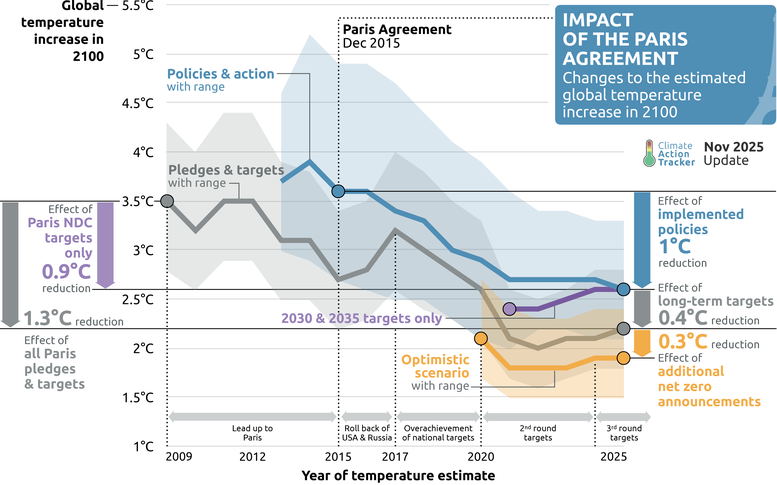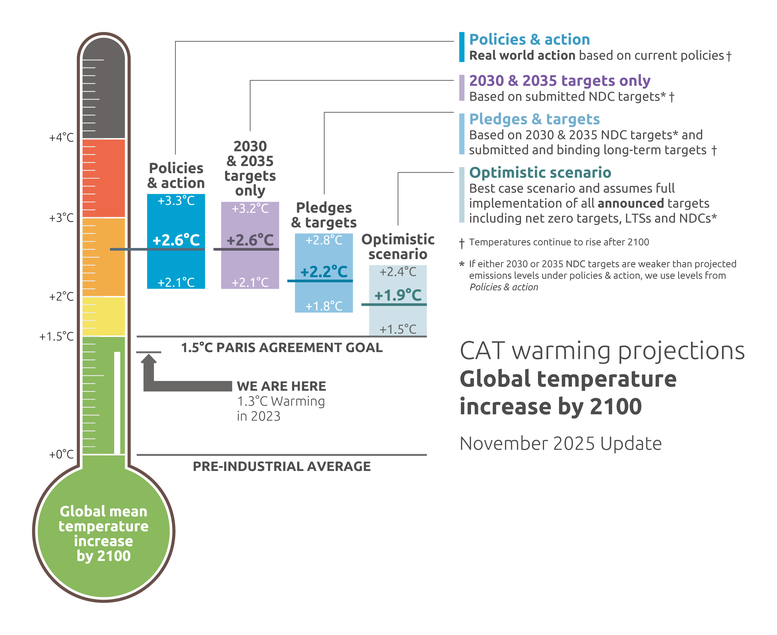Little change in warming outlook for four years; new 2035 climate targets make no difference
Attachments
Summary
Ten years after the Paris Agreement, the world stands at a critical juncture in the fight against climate change, with little to no measurable progress in warming projections - for the fourth consecutive year, as Climate Action Tracker’s latest global update, released at the COP30.
Almost none of the 40 governments the CAT analyses have updated their 2030 target, which is critical to keep warming levels below 1.5°C, nor have they set out the kind of action in new 2035 targets needed to change course.
Our global temperature projections based on this year’s policy developments and 2035 targets have almost come to a standstill: it has barely moved over the past four years. The warning signs are clear: we are heading in the wrong direction.
Progress in the ten years since the Paris Agreement
Our analysis shows the Paris Agreement works. We can see the improvements in the global temperature projections over time. Back in 2015, our assessment of existing policies showed the world was on track to around 3.6°C of warming by 2100. Now, ten years later, our latest projections show that this has been reduced by roughly 1°C to around 2.6°C.
The Paris Agreement has reshaped scientific and policy approaches, pushed investment in clean technologies, and driven national reforms that would likely not have happened otherwise.
The most serious concern now is that the progress shown in the first five years after Paris, up until around 2020, has flattened off – just as visible signs of dangerous climate change have emerged vividly around the planet.

So far, 2035 NDCs have failed to move the needle
Despite the new round of 2035 targets, global climate ambition has barely shifted. Our latest analysis shows that emissions under current NDCs and long-term targets are projected to reach 53-57 GtCO2e in 2030 and 48-52 GtCO2e in 2035 – far above the levels consistent with a 1.5°C pathway, which would require emissions to fall to 27 GtCO2e by 2030 and 21 GtCO2e by 2035.
The gap between countries’ targets and the 1.5°C pathway is widening rather than closing. By 2030, the “target gap” stands at around 26-29 GtCO2e, increasing to 26-31 GtCO2e by 2035. This means that even if all current NDCs were fully implemented, global emissions in 2035 would still be more than double (~125%-150%) the level required for 1.5°C compatibility.
The road ahead: urgency and opportunity
Renewable energy and electric vehicle deployment are breaking records and investment in clean manufacturing capacity is growing rapidly. Yet governments still failed to come forward with stronger climate commitments.
Now is the time to recognise what the Paris Agreement has set in motion, appreciate the progress it has driven so far, and stand up for it as the backbone of the world’s response to climate change.
Every fraction of a degree will translate into devastating losses for people and ecosystems across the world. Governments must urgently strengthen or overachieve 2030 targets, implement robust policies, and ensure transparency and accountability.
The Paris Agreement has set the framework; now, real leadership and ambition are needed to deliver on its promise and safeguard a sustainable future.
Find out more
Click the button below to read the full briefing document for further details on the global temperature update.
Stay informed
Subscribe to our newsletter

